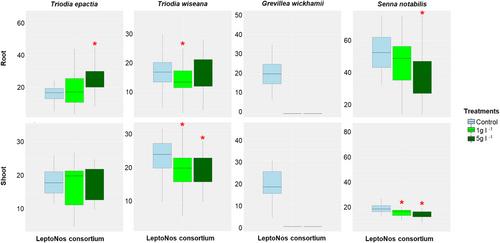Biocrust cyanobacteria have a large potential as biofertilizers for restoring degraded ecosystems because of their ability to improve soil nutrition and stabilisation, and to produce metabolites such as phytohormones to enhance plant growth. However, important aspects regarding the effects of cyanobacteria on native plants, such as metabolite production or concentration of inoculants, remain unknown. Here, we investigated the effects of different concentrations of cyanobacteria, on the germination and seedling growth of keystone plant species used in dryland restoration. We hypothesised that the studied inoculant would improve germination and seedling growth rates, with specific effects associated with the inoculant's concentration and metabolomic profiles.
We bioprimed seeds of four native plant species, using a cyanobacterial inoculant with different proportions of Nostoc and Leptolyngbya at two different concentrations. We recorded germination, measured seedling growth, and determined the corrected vigour for each treatment and species. Metabolites produced by the cyanobacterial inoculant were assessed to identify plant growth hormones potentially driving any effects.
There was a clear positive effect on the total germination of Triodia epactia and Triodia wiseana, but negative impacts for Senna notabilis and Grevillea wickhamii. There were also positive effects on root growth, but only for T. epactia, with negative or neutral impacts on the root and shoot growth of other species tested. We detected phytohormones, salicylic acid and indole-3-acetic acid, that were produced by our cyanobacteria inoculant, which are strongly linked to positive effects in early plant growth stages, but also known to inhibit growth when in higher concentrations.
The positive effects of the biopriming protocol used are not uniform and highlight the need to improve our understanding of the effects provided both from different consortia and the concentrations applied when inoculating. There is a very high value in improving restoration outcomes for native vegetation communities in arid and semi-arid regions.


